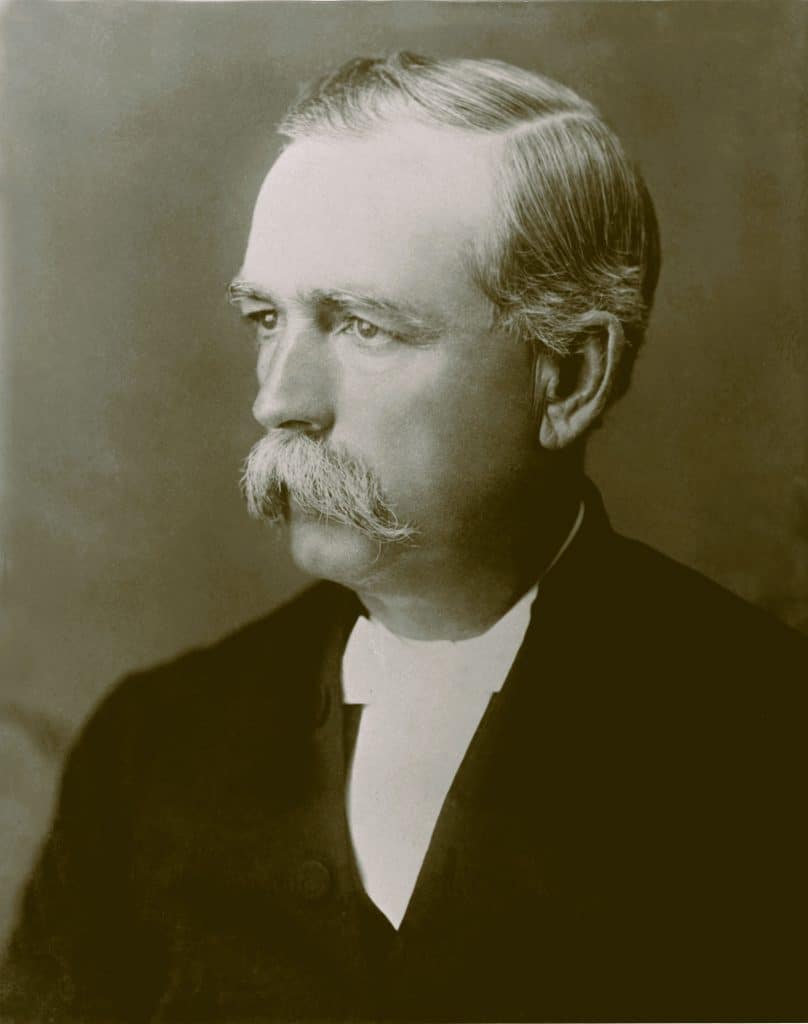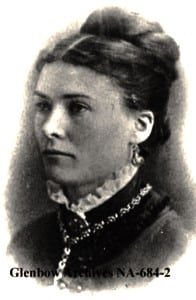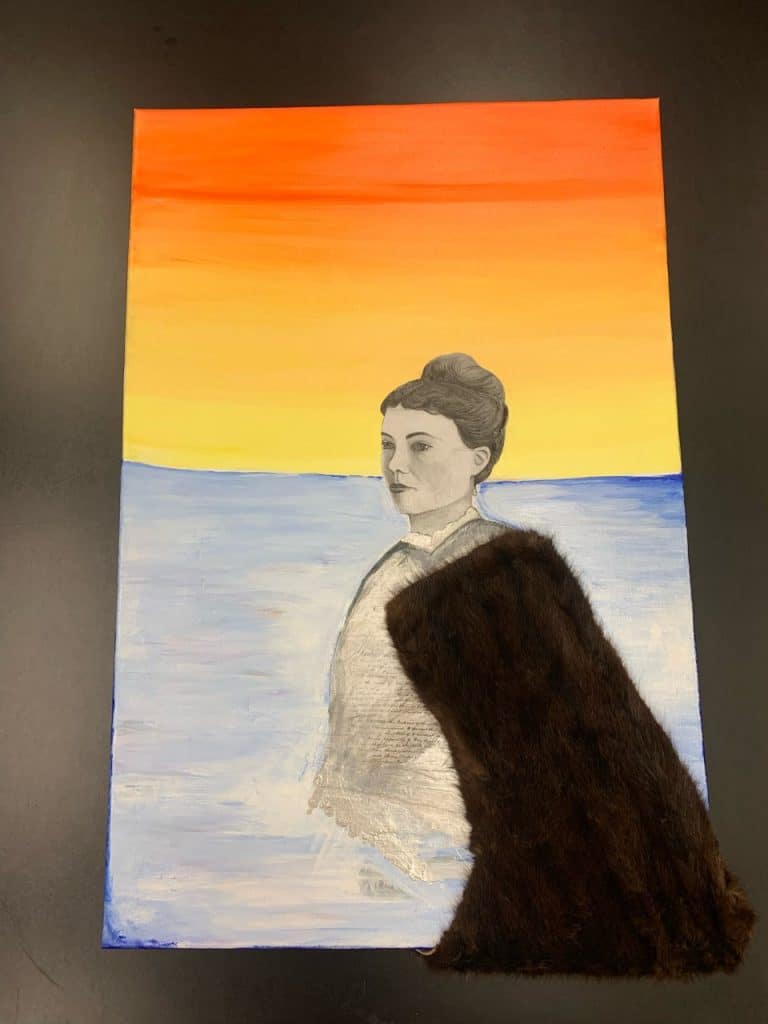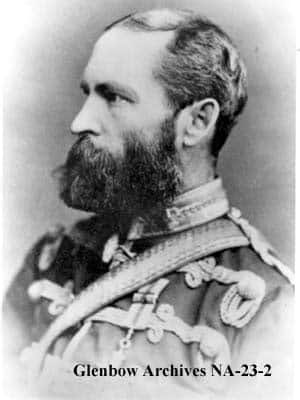
Glenbow Archives Image NA-23-2
Colonel James Farquharson Macleod, 1836-1894
In 1860, James F. Macleod passed his bar examinations at Osgoode Hall and articled at the Kingston law office of Alexander Campbell. He practiced law for a decade at Bowmanville Ontario (Durham) however, his true interest lay in serving in the militia. In 1870, through the political influence of his former employer Alexander Campbell, now a cabinet minister in the dominion government of Prime Minister Sir John A. Macdonald, Macleod obtained a commission as brigade major with the expedition under Colonel Wolseley and was sent west to help quell the Louis Riel uprising in the Red River settlement. The arduous journey westward through the wilderness was ideally suited for Macleod’s talents and his leadership earned him praise and a promotion to Commissioner of the North-West Mounted Police (NWMP).1
The Great West March
In 1874-75, Macleod and the NWMP rode out west to establish Fort Walsh and provide protection to settlers and First Nation peoples from American fur traders (“wolfers”), whisky traders, and the US cavalry who sought vengeance against the Indigenous population in the aftermath of the Sioux Indian Wars. The Indians respected and trusted Macleod and he was known to be a good man who acted in good faith.
In 1875, as Commissioner of the NWMP, James Farquharson Macleod and his men arrived by horseback at the confluence of the Elbow and Bow rivers. Macleod was struck by the similarity in appearance of his surroundings and its resemblance to the rolling foothills and rocky shoreline of “Calgary Bay” located on the Isle of Mull, Scotland, a place bearing many fond childhood memories.
The Signing of Treaty 7, September 22, 1877
David Laird, James & Mary Macleod were witnesses and signatories to Treaty 7
22 September 1877
By 1877, the buffalo had been virtually wiped out, bringing unemployment, alcoholism and a rise in indiscriminate violence. Treaty 7 was signed on September 22, 1877, between the Honourable David Laird, Lieutenant-Colonel James F. Macleod (representing the Crown), and Chief Crowfoot representing Indigenous stakeholders. The Treaty marked an attempt to establish land boundaries and to provide for provisions and education. However, having no reliable interpreter present at the signing of Treaty 7 meant the First Nation communities were largely unaware of events transpiring. Chief Crowfoot, having witnessed the destruction of the bison and traditional way of life, wrote a declaration of loyalty to Queen Victoria. The arrival of settler’s meant the end of fort hunters, fur trappers and sustenance provided by the buffalo.
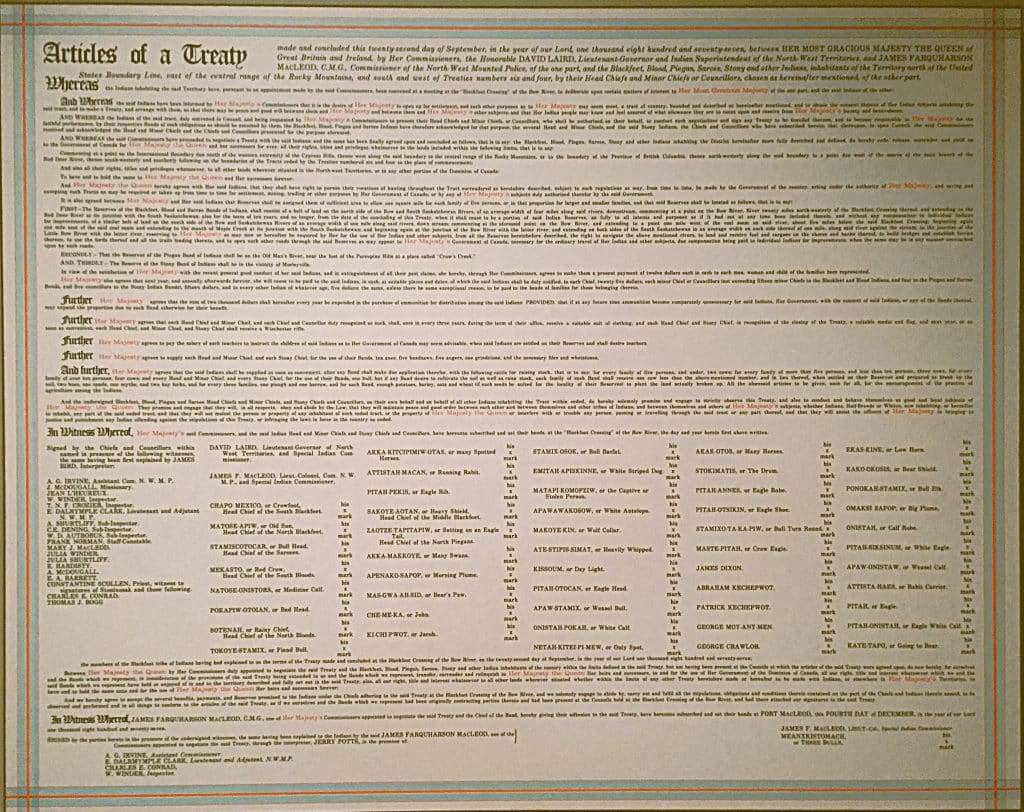
Colonel Macleod died in 1894. His wife Mary lived until 1933, long enough to be present at the 50-year anniversary of the signing of Treaty 7. She herself having been a signatory and witness.
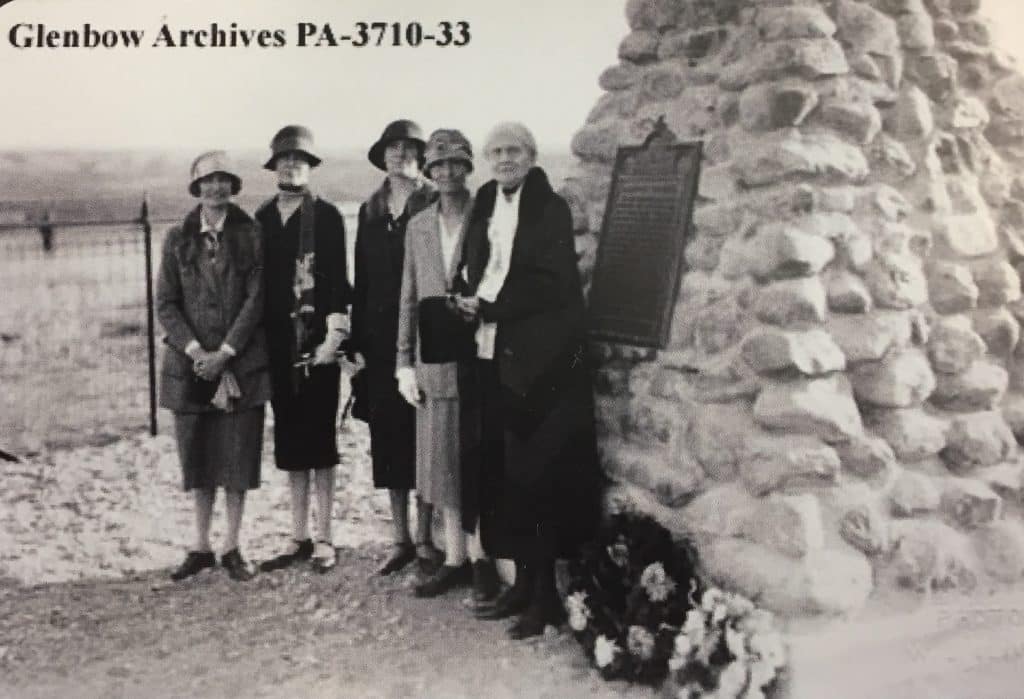
At the Blackfoot Crossing cairn, marking the place where on September 22, 1877, the treaty was signed.2
Early Calgary Court History
In 1876, Colonel Macleod (namesake of Macleod Trail, and Fort Macleod), was appointed a Stipendiary Magistrate becoming Calgary’s first resident Judge. Up until then Calgary remained uninhibited by law or its sanctions. An 1874 Act provided for the appointment and maintenance of salaried Stipendiary Magistrates. This legislation confirmed the Court of Queen’s Bench of Manitoba as the highest court in the North-West Territories. The Act also created the NWMP, giving the force sweeping powers to enforce the law. The NWMP were a quasi-military force empowered to arrest and prosecute offenders.
The Demise of the Stipendiary Magistrates and the Establishment of the Supreme Court of the Northwest Territories occurred on February 18, 1887.
Shortly after the Riel Rebellion, the Supreme Court of the North-West Territories replaced the Stipendiary Magistrate system. The new system contemplated appeals by forming an appellate tribunal sitting en banc. The appeals were initially heard in Regina twice a year and later in Calgary. Calgarians James F. Macleod, Hugh Richardson, and Judge Charles Rouleau became the inner core of the new court which existed for 20 years before disbanding after Alberta was made a Province in 1905.
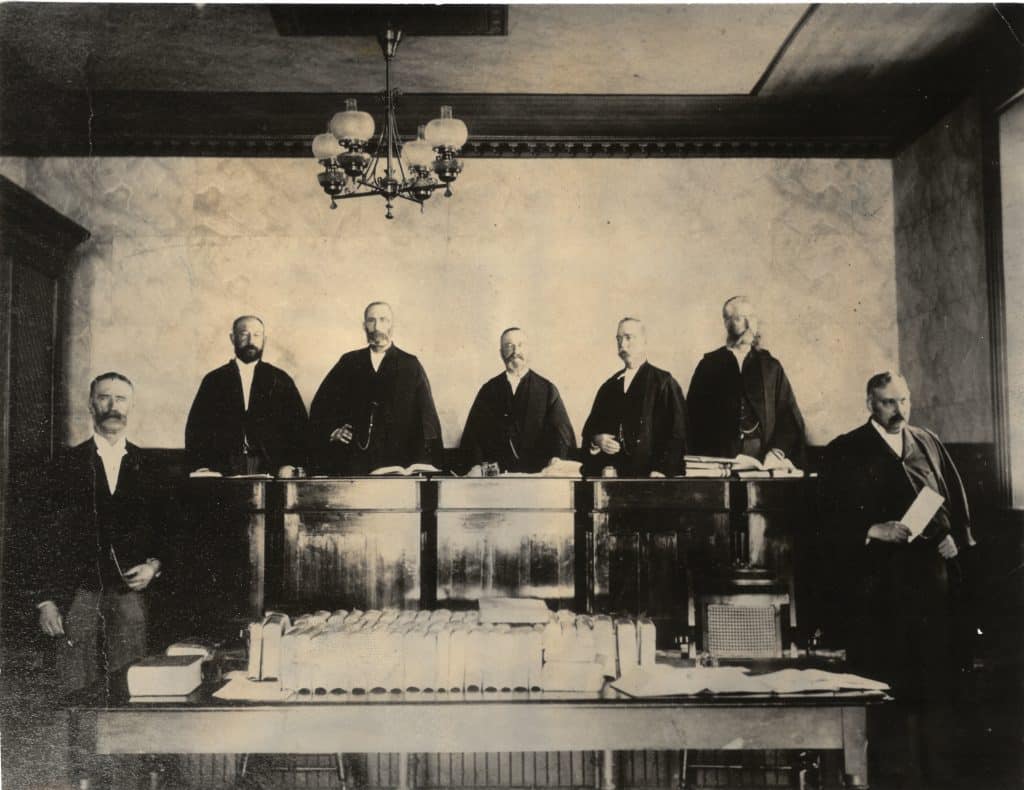
L-R: Sheriff J.H. Benson, Judge Edward L. Wetmore, Judge James F. Macleod, Judge Hugh Richardson, Chief Judge Charles B. Rouleau, Judge Thomas H. McGuire, and Dixie Watson (Clerk). LASA Image #5-G-66
Mary Isabella Macleod (nee Drever), 1852-19333
The wife of James F. Macleod played a prominent role in the development and culture of Calgary society. The Macleod’s had four daughters and a son. One daughter Helen, married Alfred Ernest Cross (of “Big Four” Stampede fame / founder of the Calgary Brewing & Malting Company), uniting two family dynasties. Granddaughter Mary Dover, a city builder in her own right, was a long-time Calgary Alderman who commanded the Canadian Women’s Army Corps during WWII.
Mary has an interesting backstory that bears mentioning. She was one of three Drever sisters from the Manitoba Red-River colony where the Hudson’s Bay Company employed her father. All three Drever sisters made their home in Calgary.
Mary’s sister Jean was married to the famous Anglican Bishop William Cyprian Pinkham, and her other sister Cristiana was married to Calgary lawyer John Pascoe Jermy Jephson.
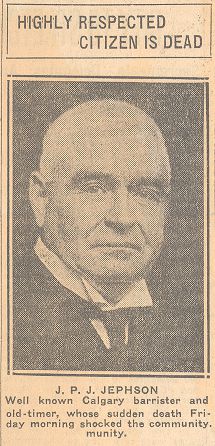
J.P.J. Jephson was one of the first lawyers in Calgary, coming in 1886 and admitted to the Bar by his neighbor Judge Charles Rouleau. He practiced law between 1892 and 1919 with James Muir, KC (first President of the Law Society of Alberta) at the law firm Jephson, Muir and Adams.
Jephson was a prominent Calgarian, first president of the Ranchmen’s Club, and one of the founders of the Calgary Bar Association. His son, a student lawyer, was killed in action during WWI and whose name is included on the 1921 memorial plaque. His wife Christiana Drever (sister of Mary) witnessed the Riel Rebellion and gave evidence at Louis Riel’s trial.
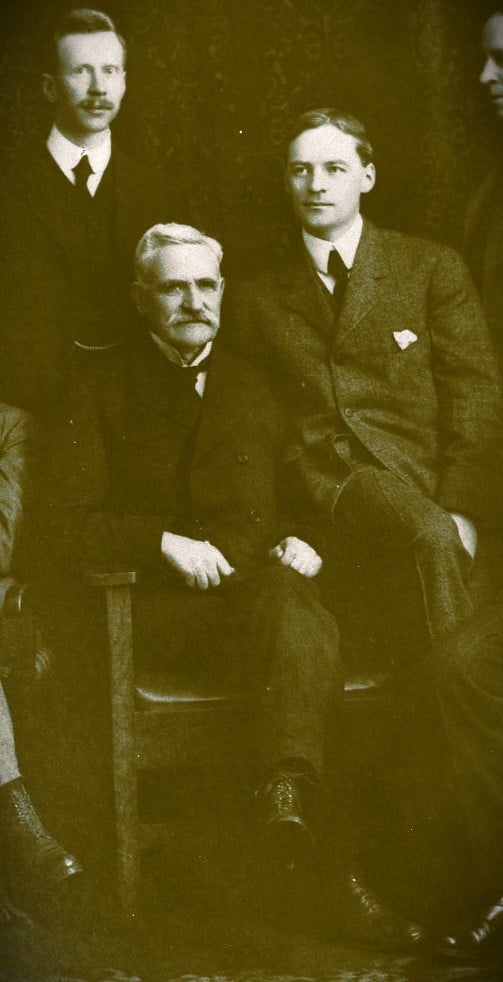
-Cropped from LASA Image #5-G-45

- The Glenbow Archives (housed at the University of Calgary Archives), holds the photographs and records of the Macleod family, including a valuable collection of transcribed letters between James and Mary that have been transcribed, digitized and are available for viewing online at: https://searcharchives.ucalgary.ca/james-f-macleod-family-fonds ↩︎
- From the ‘Directory of Federal Heritage Designations’ page for ‘Blackfoot Crossing National Historic Site of Canada’. Blackfoot crossing is located near Cluny, Alberta. The site includes the grassy floodplain of the Bow River valley, south of the river known as Treaty Flats on the reserve of the Siksika Nation, as well as the original location of the ford over the Bow River (Blackfoot Crossing), the flood plain, and terraces to the north of the ford. Within the boundaries of the site there are numerous archaeological resources and historical features including Crowfoot’s grave, Earthlodge Village and Treaty No.7 Signing Site National Historic Sites of Canada and the campsite locations of the five Blackfoot Confederacy Nations (Tsuu T’ina, Kainai, Siksika, Nakoda, and Piikani) who signed Treaty No. 7. ↩︎
- From the ‘Dictionary of Canadian Biography’ entry for James Farquharson Macleod at: https://www.biographi.ca/en/bio/macleod_james_farquharson_12E.html ↩︎



